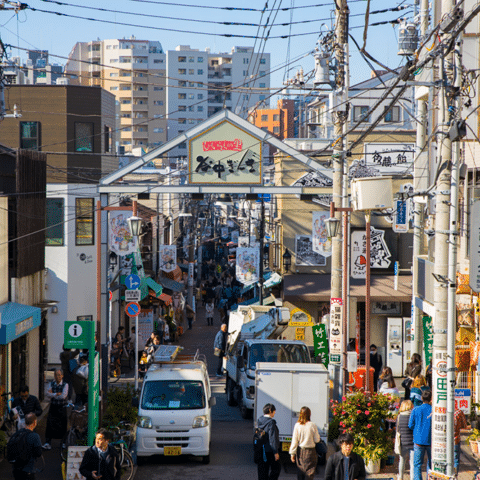
Sakuramochi: See Beautiful Cherry Blossoms, then Eat Them?!
Have you ever looked at a Japanese cherry tree in full bloom and thought, “gee whiz those leaves look delicious!”? … Me neither. Thankfully, Sakamoto Shinroku did! In recent years, the ever-hip, ever-trendy Starbucks has been selling Sakura-inspired drinks and sweets during the cherry blossom season, but this is far from a new fad. Sakuramochi, a seasonal play on the beloved pounded, rice, sweet dates back to the early 1700s, well before Captain Starbuck ever sailed into Pacific Waters. So what makes this wagashi 和菓子 (Japanese traditional sweets) different from the many iterations of mochi available year round?
The history
Hanami 花見 (cherry blossom viewing) has a long history in Japan. The short-lived blooms have caught the eyes, ensnared the hearts, and inspired the pens of innumerable Japanese lying idly beneath their branches. By the Tokugawa (Edo) Period (1603-1868), hanami was a codified and cherished part of the culture. So much so that Shogun Tokugawa Yoshimune decided to turn the banks of the Sumida River near Chomeiji Temple into a sakura garden. Noticing the plethora of green cherry blossom leaves, a gatekeeper of the temple, Sakamoto Shinroku, decided to pickle them in brine (a common food-preservation and flavoring technique called shiozuke 塩漬け) so as to preserve them for next year’s blossom events.
Now, pickled leaves didn’t exactly fly off the shelves, but that salty tang wrapped around a sweet ball of mochi sure did!–modern sweets embrace this salty/sweet mix all the time. Yamamoto’s creation became so popular that it was shown in paintings at the time and has persisted as an integral part of the hanami season up to the present era. Even now, the descendants of Yamamoto Shinroku continue to sell Sakura Mochi near Chomeiji Temple in Tokyo.
The preparation
Mochi is basically rice, water, some sugar, and a ton of elbow grease. Once the rice has been thoroughly pounded into a gooey paste, it can be cut and formed into balls, rolls, or any shape that you think rice should be. Mochi is used in many kinds of Japanese dishes and sweets, including daifuku 大福, ozoni お雑煮, and dango 団子. Sakuramochi is usually in a ball form, or flattened and then rolled. It is generally colored pink or red and mixed with fruits or anko (bean paste) for more variety of flavor.
At this point, the sakuramochi is no different from other kinds of mochi. What makes it special is the leaf. Sakura tree leaves are steeped in brine and allowed to pickle. Once they are dried, they are wrapped around the rice cake, completing the sakuramochi. This dish can be served as is, heated in a microwave, or slightly roasted in an oven toaster to bring out the sugars.
The taste
Salt and sugar help the world go ‘round. These two essential nutrients are what give sakura mochi its popular appeal. Rest assured: you are supposed to eat the leaf! While sushi and other washoku dishes are sometimes wrapped in leaves for decoration, the leaf around sakura mochi is an integral part of the taste. Not only does it provide a pinch of salt to accent the sweetness of the mochi (and whatever fruits or anko have been added), but it provides a texture that can increase your chewing pleasure. Be sure to try several colors and variations of sakura mochi to find which flavor you like the best!

The place (and time)
Obviously, sakuramochi is a seasonal food to be enjoyed during the cherry blossom season in early spring. While it’s not impossible, you will be hard pressed to find it outside of this time. Tokyo’s Sumida River and Chomeiji Temple are particularly famous for its creation, but sakura mochi can be enjoyed throughout the country with local variations adding to the experience.

In general, there are two major styles: Kansai and Kanto. Sakuramochi in Kansai is famous for being made from Domyoujiko 道明寺粉 (rice powder from Domyouji Temple) in Osaka–this rice powder has been used for more than 1000 years by warriors because it is easy to bring on long marches. In Kanto, the mochi is made from flour that has been steeped in water, dried, and lightly baked, creating a soft shell around the gooey center. Both Kanto and Kansai sakuramochi can be found throughout the country at supermarkets, convenience stores, and from street vendor stalls during cherry blossom season.
Citations:
“桜もちの歴史.” 桜の食文化300周年委員会, 桜の食文化300周年委員会, 17 Feb. 2017, sakura300.sub.jp/history/.
撮影・三浦康史 料理・大森いく子 料理コーディネート・中島久枝. “桜餅.” KIKKOMAN, Kikkoman, www.kikkoman.co.jp/homecook/search/recipe/00002671/index.html.
“和菓子ものがたり | 和菓子を知る | 和菓子の由来.” 全国和菓子協会, Japan Wagashi Association, 2011, www.wagashi.or.jp/monogatari/shiru/yurai.php.





